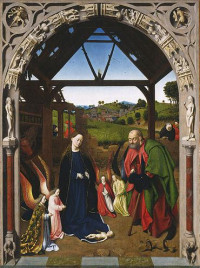|

The Nativity is a devotional mid-1450s oil-on-wood panel painting by the Early Netherlandish painter Petrus Christus. It shows a nativity scene with grisaille archways and trompe-l'œil sculptured reliefs. Christus was influenced by the first generation of Netherlandish artists, especially Jan van Eyck and Rogier van der Weyden, and the panel is characteristic of the simplicity and naturalism of art of that period. Placing archways as a framing device is a typical van der Weyden device, and here likely borrowed from that artist's Altar of Saint John and Miraflores Altarpiece. Yet Christus adapts these painterly motifs to a uniquely mid-15th century sensibility, and the unusually large panel – perhaps painted as a central altarpiece panel for a triptych – is nuanced and visually complex. It shows his usual harmonious composition and employment of one-point-perspective, especially evident in the geometric forms of the shed's roof, and his bold use of color. It is one of Christus's most important works. Max Friedländer definitely attributed the panel to Christus in 1930, concluding that "in scope and importance, [it] is superior to all other known creations of this master."






 Please share your ideas with us.
Please share your ideas with us.